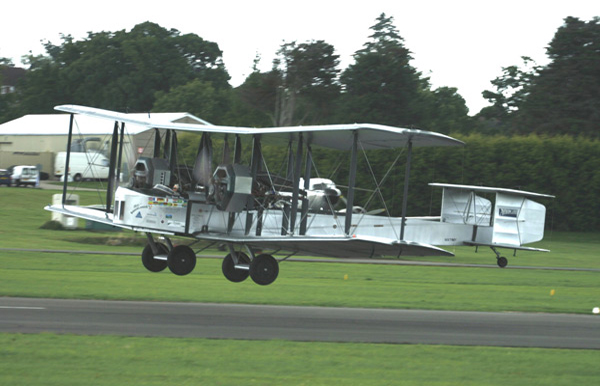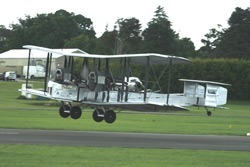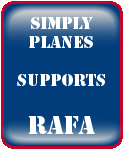Vickers Vimy

Vickers FB-27 Vimy NX71MY/G-EAOU replica at Dunsfold Wings & Wheels Air Show 2008. Photo by Bob Franklin
The Vickers Vimy was a World War I British heavy bomber, designed by Reginald Kirshaw Pierson and manufactured by Vickers Limited. It was first flown on 30th November 1917. The Vickers Vimy became popular with the military and as a civilian aircraft alike. The Vickers Vimy set a number of notable records in long-distance flights during the interwar period. The Vimy had a maximum speed of 100 mph (161 km/h) and was armed with a .303 in (7.7 mm) Lewis Gun and 2476 lb (1123 kg) of bombs.
The chief designer of Vickers Limited in Leighton Buzzard, Reginald Kirshaw "Rex" Pierson was asked to design three prototypes on 14th August 1917. He designed a twin-engine biplane (the Vickers F.B.27) a night bomber that needed to be able to be capable of attacking targets in Germany. The first prototype had two 200 hp (150 kW) Hispano Suiza engines. The Vickers Vimy was named after The Battle of Vimy Ridge. Testing began with a number of engines, including the 230 hp (170 kW) BHP Puma, 400 hp (300 kW) Fiat, 400 hp (300 kW) Liberty L-12 and the 360 hp (270 kW) Rolls-Royce Eagle VIII engine. Vimys powered with the Rolls-Royce Eagle engines were delivered to the RAF, these were known as the Vimy IV.
Three aircraft were delivered to the RAF by October 1918. One of these went to France to be used by the Independent Air Force. The Vimy only reached full service status in July 1919 with 58 Squadron in Egypt. It became the main heavy bomber force of the RAF for most of the 1920s. From 1919 up until 1925 the Vimy served as a front line bomber in the Middle East and the United Kingdom, it was then replaced by the Vickers Virginia. The Vimy continued to be used as a training aircraft, the last Vimys were used as target aircraft for searchlight crews up until 1938.
A few variants of the Vickers Vimy were designed, the F.B.27 Vimy, the prototype aircraft. A twin-engine heavy bomber, the F.B.27A Vimy II. The Vimy Ambulance (an air ambulance version designed for the RAF) and the Vimy Commercial.
The Vimy Commercial was a civilian version of the Vickers Vimy. It was designed with a larger fuselage which was mainly made of spruce plywood. The Vimy Commercial first flew on 13th April 1919 at Joyce Green Airfield in Kent. The aircraft had the civil registration of K-107 and was later re-registered as G-EAAV. The prototype of the aircraft was entered into the 1920 race at Cape Town, it crashed on 27th February at Tabora, Tanganyika. 55 military transport versions of the Vickers Commercial were built for the RAF as the Vickers Vernon. A number of bomber versions of the Vickers Commercial were used in both the Zhili-Fengtian Wars.
Long-distance flights
The most significant record flight in a Vickers Vimy was the first nonstop crossing of the Atlantic Ocean, this was done by Alcock and Brown in June 1919. The aircraft they flew across the Atlantic in is preserved in The London Science Museum, the aircraft crashed on 15th June 1919 at Clifden in Ireland.
In 1919 the Australian government offered £10000 for the first all-Australian crew to fly an aeroplane from England to Australia. On 10th December 1919 the journey was completed by Keith Macpherson Smith, Ross Macpherson Smith and two other men in Vickers Vimy G-EAOU.
An attempt at the first England to South Africa flight was made in 1920 by Lieutenant Colonel Pierre van Ryneveld and Major Quintin Brand. On 4th February 1920 they took off from Brooklands in Vickers Vimy G-UABA, which was named Silver Queen. The engine overheated and they were forced to land at Heliopolis in Cairo, Egypt. The RAF at Heliopolis loaned them a second Vickers Vimy, named Silver Queen II. The aircraft got as far as Bulawayo in Southern Rhodesia, there it was badly damaged when it failed to take off. They borrowed an Airco DH.9 to continue the rest of the journey, they were disqualified as the winners but still got £5000 each.
Surviving Examples
A replica cockpit section of a Vickers Vimy was built by Vickers for The London Science Museum during the early 1920s.
A film about Alcock & Brown's transatlantic flight was in the pipeline but got cancelled, a replica was built by British Lion Films from Shawcroft Models Ltd of Iver Heath, Bucks for the film and was never used. The aircraft was used at The Battle of Britain Air Display at RAF Biggin Hill in 1955 and since then is unheard of.
The Vintage Aircraft Flying Association at Brooklands built a replica registered G-AWAU in 1969. D G 'Dizzy' Addicott and Peter Hoare first flew the aircraft, it was damaged by a fire. It is now displayed at The RAF Museum, Hendon in London.

In 1994 a team led by Lang Kidby and Peter McMillan built a replica, NX71MY. This aircraft recreated the three great Vimy flights. In 2006 the aircraft was donated to The Brooklands Museum in Weybridge, Surrey. On 15th November 2009 the final flight of the aircraft was made. NX71MY was dismantled and moved to the museum to be reassembled by a volunteer team to be set up for display. (Shown left - photo Bob Franklin)




